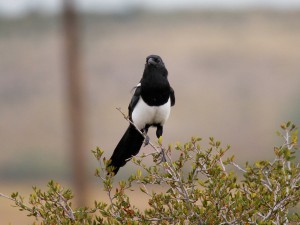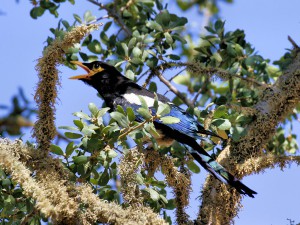Magpie Origin

This Black-billed Magpie was photographed in Denver Colorado. It is common to see either of the American Magpie species walking on the ground foraging for food.
The magpies of North America are very visually distinctive from other birds and thus easy to identify. Although the Black-billed Magpie is very similar in appearance to the European Magpie, it is larger and genetically unique. DNA analysis places our two magpies as separate from the European Magpie. DNA distinctions caused the AOS to divide the American Magpies from the European Magpies. The same logic should apply to the Korean subspecies. The ancestral magpies, after dispersing across Eurasia and becoming isolated in Korea, then crossed over the Bering Land Bridge into the Americas at about 3 to 4 million years ago.Strictly speaking, using DNA comparisons, the AOS (American Ornithological Society) could potentially merge our two magpie species.
Magpie Range

This Yellow-billed Magpie was photographed in the Central Valley of California. Like the Black-billed Magpie photo above this Yellow-billed Magpie is foraging for food on the ground.
West of the Sierra Nevada Mountains in the Central Valley of California, Yellow-billed Magpies are a California endemic bird species. You can find Black-billed Magpies east of the Sierra Nevada Mountains, as far north as coastal southern Alaska, and east as far as Minnesota and Iowa. These ranges do not overlap although the Black-billed Magpie tends to wander and may occasionally (rarely) end up south into the northern range of the Yellow-billed Magpie. The two North American magpies have separate and distinct ranges. They are also easy to visually distinguish by bill color. The magpies are part of the Corvidae family, which includes ravens, crows, and jays.
Magpie comparison

This Black-billed Magpie was photographed east of the California Sierra Mountains just north of Mono Lake. The Sierras Nevada Mountains separate the magpie species ranges.
Our two North American magpies sound very similar. They are very vocal. Usually, you will hear them before seeing them. There are two common vocalizations. First, there is a rapid nasal “yak yak yak” vocalization. The second is a slower and higher pitched ascending call described as “maaag maaag maaag”.
The Black-billed Magpie is slightly larger than the Yellow-billed Magpie (19 inches vs. 16 ½ inches in length). Both magpies have extremely long tails. These are two of only four indigenous birds in North America that have a tail length greater than their body length. The Scissor-tailed Flycatcher and the Fork-tailed Flycatcher are the other two. Other than the major visual difference of bill color and slightly smaller size the Yellow-billed Magpie also has a variable amount of yellow skin around the eye. It has been suggested that the amount of yellow around the eye may be both genetic and a function of molt sequence timing. The Black-billed Magpie lacks this marking or bare skin around the eyes.
Magpie plumage description
Other than the differences discussed above, Yellow-billed Magpies and Black-billed Magpies are virtually identical. The magpies have a black head, throat, upper breast, and tail. The shoulders, lower breast, and belly are white. The wings, tail and body have an iridescent blue with bronze or green sheen. In flight large white patches show on the primary wing feathers. The bright color contrasts make the magpies very distinctive in appearance and easy to distinguish.
Magpie social habits

Although still considered quite social, the Black-billed Magpie is more solitary than the Yellow-billed Magpie.
Magpies are intelligent and bold. They are also very social birds. Yellow-billed Magpies are significantly more gregarious than Black-billed Magpies. They (Yellow-billed) are more social in their habits, communal in nesting, and roosting. Yellow-billed flocks even exhibit funeral like behavior for their dead. Both birds mate for life and spend year round with their mate. The caveat of this is that divorce may occur! One South Dakota study showed a very low divorce rate for Black-billed Magpies of 8% although another study in Alberta showed divorce rates as high as 63%. It would appear the American magpies show much higher marriage fidelity than the Canadian magpies!
Magpie breeding

The amounts of yellow in the face can vary quite a bit with the Yellow-Billed Magpies as seen in this individual.
Both Yellow-billed and Black-billed Magpies build a dome over their nest for a nice cozy nursery. Yellow-billed are more social and nest in a loose, communal area. Black-billed Magpies generally build their nests separate from each other. The male feeds the female during brooding in the case of both magpies. Both males and females share in feeding the young thereafter. Being highly social seems to have some drawbacks for male Yellow-billed Magpies. The problem with the communal social structure is that with Yellow-billed Magpies extra-pair copulation is not uncommon. After mating, the male will guard the female to prevent her from mating with other males until she actually starts to lay eggs. Makes you wonder what the divorce rate amongst Yellow-billed Magpies is!

